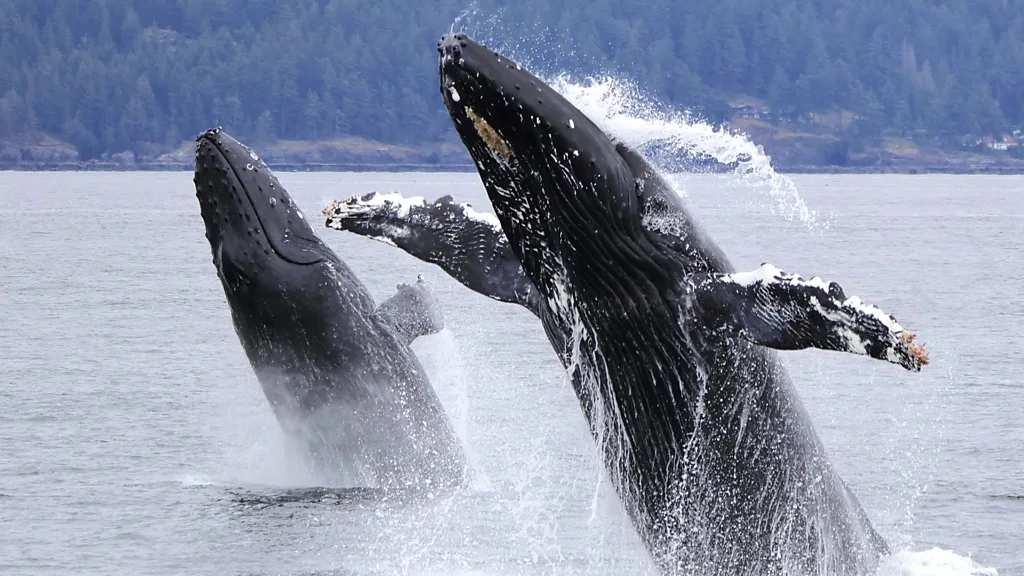Humpbacks in Hot Water: Why Climate Change is the Next Big Threat
Humpback whales are some of the ocean’s greatest survivors. After nearly being wiped out by whaling, their populations have bounced back thanks to global efforts like the commercial whaling ban and national protections. Big Mama, one of the first humpbacks to return to the Salish Sea in decades, symbolizes this remarkable comeback. Her homecoming in the late 1990s marked a turning point for humpbacks, especially in places like the North Pacific. From fewer than 1,000 humpbacks in 1986 to thousands today, it’s a story of hope. But now, just as they’ve regained their footing, a new crisis looms: climate change.
The Climate Crisis is Here
Whales, like Big Mama and her descendants, are now faced with an unpredictable future. Climate change is reshaping the oceans, and the impacts on marine life are profound. Rising ocean temperatures don’t just make the water warmer—they disrupt entire ecosystems, altering food availability, migration patterns, and breeding grounds. For humpbacks, whose survival depends on traveling vast distances between their feeding and breeding grounds, this is a huge problem.
The humpbacks’ migration is one of the longest of any mammal on Earth, with some traveling over 3,000 miles from Alaska to Hawaii. These waters are crucial for humpback reproduction because calves are born in warm seas, where the temperature sits between 21°C and 28°C. Calves need these specific conditions because they don’t have enough blubber to insulate them in colder waters.
But as the planet heats up, even these tropical waters are becoming too warm. According to research from the University of Hawaii, nearly 40% of humpback breeding grounds could exceed safe temperature limits by the end of this century. In the worst-case scenario, that number jumps to 67%. Imagine this: two-thirds of the areas humpbacks rely on to give birth might no longer be suitable. That’s like having a home where you can’t live anymore—it’s dangerous and uninhabitable.
A Grim Forecast
The scientists behind the research on humpback breeding grounds were shocked by the results. As one of the researchers, Hannah von Hammerstein, described, it was terrifying to see breeding ground after breeding ground turn red on their simulation maps, indicating dangerously high temperatures. Even more worrying? The situation has only worsened since the study was published. Under current emission policies, the best-case scenario—the one where the breeding grounds are still somewhat viable—may now be out of reach.
Humpbacks are resilient, but they can only handle so much. Their migratory routes, which have been consistent for eons, could be thrown off course. Already, in places like Cape Cod Bay, researchers have noticed that humpbacks are arriving weeks later than they used to. This shift is likely due to changes in their prey—whales depend on krill, a tiny crustacean that makes up the bulk of their diet. But krill populations have plummeted by 80% since the 1970s because of rising ocean temperatures and shrinking sea ice. And with fewer krill to feed on, humpbacks will struggle to get the energy they need for migration and reproduction.
Ripple Effects Beyond Whales
What happens to whales doesn’t stay with whales. These giants play a crucial role in maintaining the health of our oceans. Through what scientists call the “poop loop,” humpbacks fertilize the ocean with their nutrient-rich waste, which helps phytoplankton thrive. Phytoplankton is a cornerstone of the marine food web and absorbs vast amounts of carbon dioxide from the atmosphere. So, fewer whales could mean less phytoplankton, which in turn leads to a weaker ocean ecosystem and less carbon being absorbed from our atmosphere. It’s all connected.
We’re not just talking about the whales’ survival but the survival of entire ocean ecosystems. And if that doesn’t sound dire enough, the ripple effects could extend to us. Changes in the ocean’s balance can impact fisheries, coastal communities, and even global weather patterns.
Can We Help Save the Humpbacks?
So, what can be done to protect humpbacks from the effects of climate change? It’s a daunting challenge, but there are things we can do. First, cutting down on fossil fuel emissions is critical. The more we can slow the pace of global warming, the more time we give species like humpbacks to adapt. And it’s not just about big international agreements—individual actions matter too. Supporting renewable energy, reducing waste, and being mindful of our carbon footprint are all steps we can take.
But it’s not just about climate change. Conservationists are also working on other fronts to protect humpbacks. For example, marine protected areas (MPAs) can offer a refuge where whales are safe from threats like ship strikes and fishing gear entanglement. In the Salish Sea, efforts to make whale-watching tours more sustainable are helping to reduce noise pollution and the risk of injury from boats. Some companies have even committed to offsetting more carbon than they produce to help fight climate change.
However, there’s a delicate balance to strike between enjoying these majestic animals and ensuring their long-term survival. Ethical whale watching is possible, but it requires strict guidelines and responsible practices to minimize the impact on whales and their habitats. The growing popularity of whale-watching tourism, which is a $2 billion industry, highlights the need for sustainability in tourism. After all, without healthy whale populations, there won’t be any whales to watch.
The Future of Humpbacks: A Fragile Hope
Big Mama’s return to the Salish Sea was a symbol of hope—a sign that, with enough time and effort, species on the brink can recover. But her story, and the story of the thousands of humpbacks now populating our oceans, is far from over. Climate change is testing the limits of that recovery, pushing us to rethink how we interact with our planet and its incredible creatures.
There’s still time to protect humpbacks, but we must act quickly. The stakes are high, not just for the whales but for the entire ocean ecosystem and, ultimately, for us. We can’t afford to lose these gentle giants—they’re more than just a spectacle of nature. They’re a vital part of the intricate web that keeps our oceans healthy and balanced. Saving them means saving ourselves.
If we act now, maybe the next century will be one where humpbacks thrive, not just survive. And that’s a future worth fighting for.




